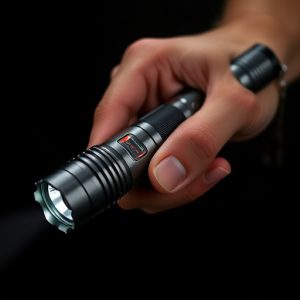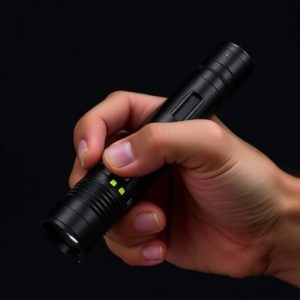Illuminating Self-Defense: A Comprehensive Guide to Flashlight Batons
The self-defense flashlight baton is a multifunctional tool designed for enhanced personal security…….
The self-defense flashlight baton is a multifunctional tool designed for enhanced personal security and situational awareness. It offers users both illumination to disorient potential attackers and a striking weapon for defense, all within one compact device. This innovative gadget simplifies the user's Everyday Carry (EDC) by combining light and self-defense capabilities, which is particularly advantageous in low-light situations. Key features of an effective self-defense flashlight baton include a high-lumen output with adjustable focus for temporary blindness, impact-resistant construction, reliable rechargeable battery power, user-friendly stun light functionality, and ergonomic design for a secure grip. Additionally, the legal aspects must be considered, as some regions have specific restrictions on baton length, brightness, and use. It's crucial to adhere to these regulations and receive proper training in the device's application to ensure both ethical and effective use, particularly in defensive situations. Regular practice is recommended to become proficient and to stay within legal boundaries. Understanding the law and responsible use are as critical as the device's capabilities for personal safety.
When darkness falls or uncertain situations arise, a self-defense flashlight baton emerges as an indispensable tool for personal safety. This article sheds light on the multifunctional nature of these devices, offering insights into their strategic role in self-defense scenarios. We will explore the critical features that distinguish an effective self-defense flashlight baton, guide you through optimal usage techniques, and address the legal considerations necessary for responsible use. As a safeguard against potential threats, understanding how to leverage a self-defense flashlight baton can provide both security and peace of mind.
Understanding the Multifunctional Role of Self Defense Flashlight Batons
A self-defense flashlight baton serves a dual purpose that enhances personal security and situational awareness. Unlike traditional self-defense tools, these devices integrate light functionality with the defensive capabilities of a baton. The combination allows users to illuminate dark environments, which can deter potential assailants by shining a bright light directly in their eyes or expose threats from afar. This multifunctional role is particularly advantageous in unpredictable conditions where visibility can be a critical factor in self-defense situations.
The baton itself is a versatile weapon; it extends the user’s reach, providing a longer striking distance compared to bare hands or smaller self-defense tools. When paired with the light feature, the user gains an additional layer of defense. The intensity of the beam can be used as an initial deterrent, and if confrontation is inevitable, the baton can be employed to defend oneself effectively. Additionally, the presence of both light and baton in one device means that users do not have to carry separate items for illumination and self-defense, streamlining their EDC (Everyday Carry) setup for convenience and optimal preparedness.
Key Features to Consider When Selecting a Self Defense Flashlight Baton
When selecting a self-defense flashlight baton, it’s crucial to consider several key features that will impact its effectiveness and your comfort during use. The first feature to evaluate is the light intensity and beam focus. A high-lumen output can momentarily blind an attacker, offering you a critical advantage. Look for a model with an adjustable focus, allowing you to switch between a wide beam for area illumination and a narrow, concentrated beam for blinding effectiveness. The durability of the flashlight baton is also paramount; it should be made from high-quality, impact-resistant materials that can withstand rough use and environmental conditions. Additionally, the battery life must be substantial enough to last during an emergency situation, preferably with a rechargeable design to ensure readiness.
Another important aspect is the baton’s stun light feature. This non-lethal function emits a high-voltage electrical current that can incapacitate an assailant without causing permanent harm. The stun feature should be activated with ease, often through a switch mechanism on the device. The baton’s size and weight are equally significant; it must be comfortable to grip and handle, allowing for precise aiming and control. Ergonomic design can enhance your ability to wield the baton effectively in self-defense situations. Lastly, consider the baton’s overall length and whether it falls within legal limits for self-defense tools in your jurisdiction. A balance between reach and portability is essential; a collapsible design that extends for added reach can be advantageous while remaining compact for storage or concealment.
Effective Techniques for Using a Self Defense Flashlight Baton
When it comes to personal safety, a self-defense flashlight baton is an invaluable tool that combines illumination with a formidable self-defense device. Its dual functionality allows users to disorient attackers and navigate dark environments simultaneously. To effectively use this device, the first technique involves using the light as a deterrent. A bright beam can temporarily blind an assailant, creating an opportunity for escape or to strike if necessary. Aim the beam directly into the eyes of the threat from a distance to maximize disorientation. Practice this maneuver in advance to ensure you can execute it with confidence and precision under pressure.
In addition to the disabling effects of the light, the baton itself can be used as an impact weapon. Striking techniques should focus on delivering force to areas of the body that are most sensitive. Targets such as the nose, knees, elbows, and solar plexus are particularly vulnerable. It’s crucial to strike with the widest part of the baton for maximum impact while minimizing the risk of injury to yourself. Training with a self-defense flashlight baton regularly will enhance your proficiency and familiarity with its effective use, ensuring you can respond appropriately should you ever find yourself in a threatening situation. Always remember to practice within the legal limits of your jurisdiction and consider taking a certified self-defense course to master the techniques associated with this versatile tool.
Legal Implications and Responsible Use of Self Defense Flashlight Batons
When integrating a self-defense flashlight baton into your personal safety strategy, it’s imperative to be aware of the legal implications governing its use. Laws vary by jurisdiction, so it’s crucial to familiarize yourself with local regulations before purchasing or using such a device. The legality of these multifunctional tools often hinges on their design and intended purpose; they are typically permitted as long as they do not exceed certain length or brightness limitations. However, the permissibility for use in self-defense situations is subject to specific conditions and justifications. For instance, many legal frameworks require individuals to attempt to retreat from harm’s way if safely possible before resorting to a self-defense flashlight baton.
Responsible use of these devices extends beyond mere legal compliance; it involves understanding the ethical considerations as well. The choice to deploy a self-defense flashlight baton should be made with caution, aiming to avoid unnecessary confrontation. In situations where using the device is justified for self-defense, it’s important to remember that its use can have serious consequences, including injury to an attacker or bystanders, and potential legal ramifications if not used within the scope of the law. Therefore, individuals should receive proper training to ensure they handle their self-defense flashlight baton with knowledge and confidence, using it only when necessary for personal safety. This training often covers situational awareness, de-escalation techniques, and the appropriate application of the device, ensuring that users are prepared to act responsibly and within the confines of the law.


